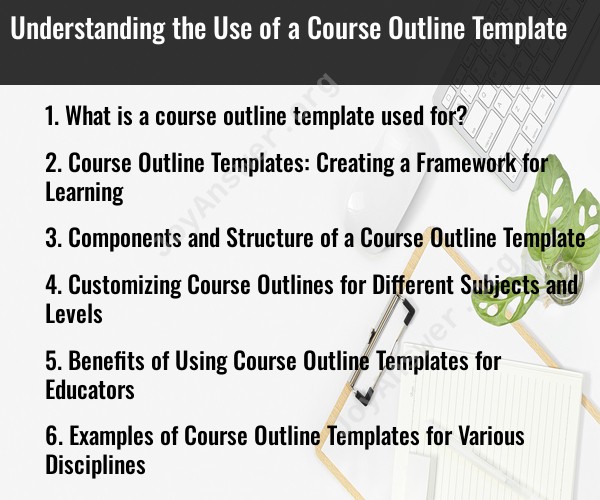What is a course outline template used for?
A course outline template is a structured document that serves as a blueprint or guide for designing, organizing, and delivering a course. It outlines the key components and elements of a course, providing instructors and students with a clear overview of what to expect. Here's what a course outline template is used for:
Course Planning and Design:
- It helps instructors plan and design a course by outlining the course's structure, objectives, and content. This includes defining the course's scope, learning goals, and desired outcomes.
Communication and Transparency:
- A course outline template is a communication tool that provides students with detailed information about the course, including its objectives, content, grading policies, and expectations. It ensures transparency and helps manage student expectations.
Curriculum Alignment:
- It ensures that the course content, assignments, and assessments align with the intended learning outcomes and broader curriculum objectives. This alignment is crucial for effective teaching and assessment.
Syllabus Creation:
- Course outlines often form the basis for creating the course syllabus. The course outline template can be used to draft the syllabus, which includes more specific details about assignments, due dates, and grading criteria.
Time Management:
- The template helps in organizing the course schedule and specifying the topics to be covered in each class session. It aids in time management and ensures that the course stays on track.
Resource Planning:
- Instructors can use the course outline template to identify and plan the resources, materials, and technologies needed for the course. This includes textbooks, online resources, and instructional aids.
Assessment and Evaluation:
- It outlines the assessment methods, criteria, and grading scale to be used in the course. This includes information on assignments, quizzes, exams, and other evaluation components.
Student Orientation:
- New students or those unfamiliar with the course benefit from the template as it provides essential information on the course's structure, expectations, and policies. It serves as a reference throughout the course.
Consistency:
- Course outline templates promote consistency in course design and delivery, especially in programs where multiple instructors may teach the same course. It ensures that key information is presented uniformly to students.
Legal and Institutional Compliance:
- The template may include information related to legal requirements, institutional policies, and compliance with accreditation standards. This is particularly important for programs in regulated fields, such as education or healthcare.
Customization:
- While the template provides a standard structure, it can be customized to suit the specific needs and goals of the course, as well as the preferences of the instructor.
Continuous Improvement:
- Course outlines serve as a valuable reference for instructors to evaluate the course's effectiveness and make improvements based on student feedback, evolving educational practices, and changing requirements.
In summary, a course outline template is a versatile tool used for course planning, communication, transparency, and effective instruction. It ensures that the course is well-structured, aligned with learning objectives, and meets the needs of both instructors and students.
Course Outline Templates: Creating a Framework for Learning
A course outline template is a pre-structured document that provides a framework for educators to develop and deliver their courses. It typically includes key components such as:
- Course title and code
- Instructor information
- Course description
- Learning objectives
- Course schedule
- Assessment methods
- Required and recommended resources
Course outline templates can be used to create course outlines for any subject or level, from elementary school to college and university. They can also be customized to meet the specific needs of the instructor and the students.
Components and Structure of a Course Outline Template
A typical course outline template includes the following components:
- Course title and code: This identifies the course and distinguishes it from other courses.
- Instructor information: This includes the instructor's name, contact information, and office hours.
- Course description: This provides a brief overview of the course, including its topics, objectives, and prerequisites.
- Learning objectives: These are specific statements that describe what students are expected to be able to do by the end of the course.
- Course schedule: This provides a week-by-week breakdown of the course, including the topics to be covered, readings, assignments, and due dates.
- Assessment methods: This describes how students will be assessed, such as through exams, essays, projects, or presentations.
- Required and recommended resources: This lists the textbooks, articles, and other resources that students will need for the course.
Customizing Course Outlines for Different Subjects and Levels
Course outline templates can be customized to meet the specific needs of the subject and level of the course. For example, a course outline for a college-level math course would likely be more detailed than a course outline for an elementary school science course.
In addition, instructors can customize course outline templates to reflect their own teaching style and preferences. For example, some instructors may prefer to include more detailed lesson plans in their course outlines, while others may prefer to keep their course outlines more general.
Benefits of Using Course Outline Templates for Educators
There are many benefits to using course outline templates for educators. Some of the key benefits include:
- Consistency: Course outline templates can help to ensure that courses are taught consistently, regardless of the instructor.
- Organization: Course outline templates can help educators to organize their courses and ensure that all of the essential components are covered.
- Time-saving: Course outline templates can save educators time by providing a pre-structured framework for developing their courses.
- Improved student learning: Course outline templates can help to improve student learning by providing students with a clear overview of the course and its requirements.
Examples of Course Outline Templates for Various Disciplines
Here are some examples of course outline templates for various disciplines:
- English: Course outline template for an English 101 course
- Math: Course outline template for a College Algebra course
- Science: Course outline template for a Biology 101 course
- History: Course outline template for a World History course
- Foreign language: Course outline template for a Spanish 101 course
These are just a few examples, and there are many other course outline templates available online and in textbooks.
Conclusion
Course outline templates are a valuable tool for educators. They can help to ensure that courses are taught consistently, organized, and efficient. Course outline templates can also help to improve student learning by providing students with a clear overview of the course and its requirements.












